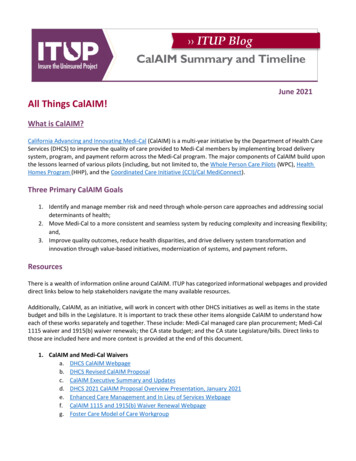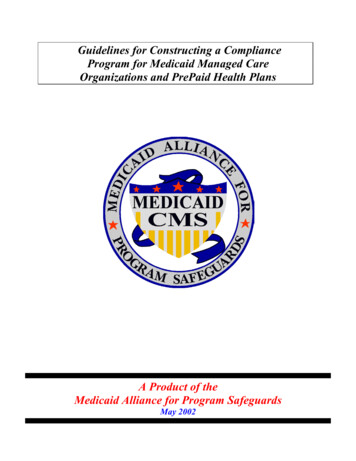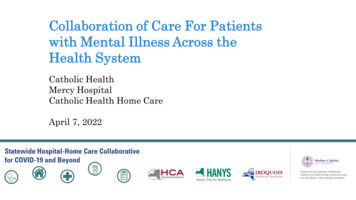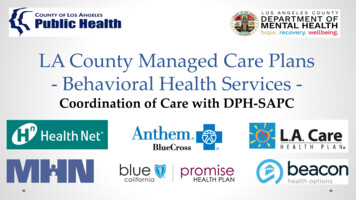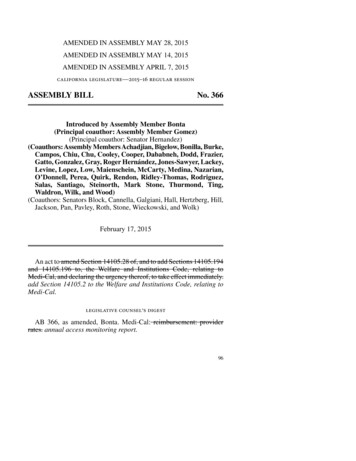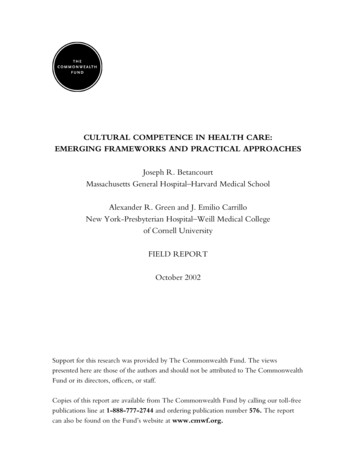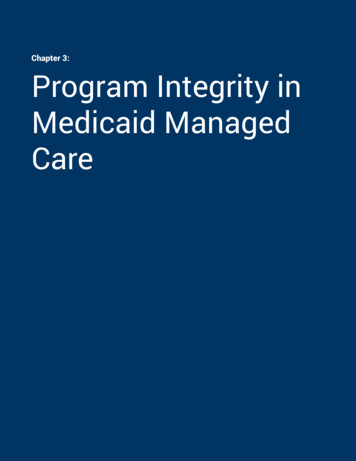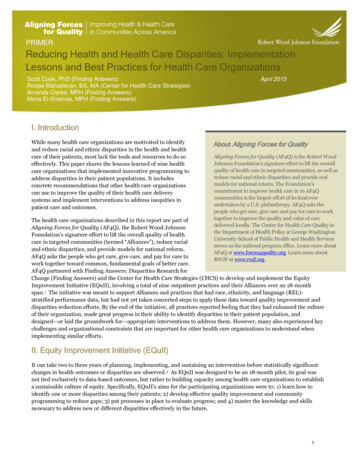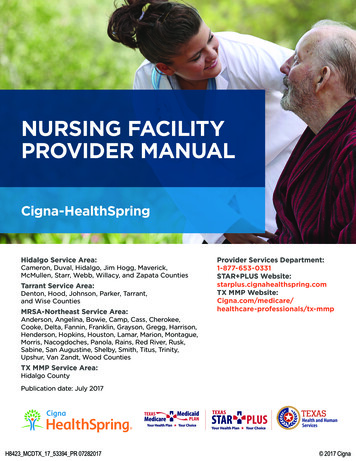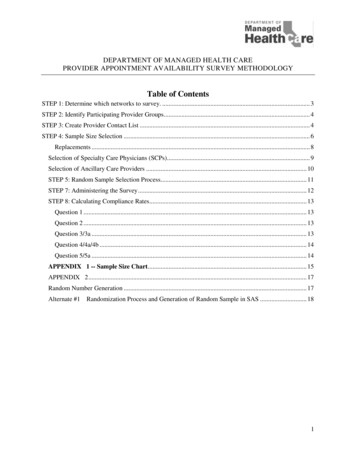
Transcription
DEPARTMENT OF MANAGED HEALTH CAREPROVIDER APPOINTMENT AVAILABILITY SURVEY METHODOLOGYTable of ContentsSTEP 1: Determine which networks to survey. . 3STEP 2: Identify Participating Provider Groups. 4STEP 3: Create Provider Contact List . 4STEP 4: Sample Size Selection . 6Replacements . 8Selection of Specialty Care Physicians (SCPs). 9Selection of Ancillary Care Providers . 10STEP 5: Random Sample Selection Process. 11STEP 7: Administering the Survey . 12STEP 8: Calculating Compliance Rates. 13Question 1 . 13Question 2 . 13Question 3/3a . 13Question 4/4a/4b . 14Question 5/5a . 14APPENDIX 1 -- Sample Size Chart. 15APPENDIX 2 . 17Random Number Generation . 17Alternate #1 Randomization Process and Generation of Random Sample in SAS . 181
Department of Managed Health CareProvider Appointment Availability Survey MethodologyIncluded below are step-by-step instructions for using the Provider Appointment Availability Survey(PAAS) Methodology developed by the Department of Managed Health Care. For Measurement Year(MY) 2015, plans are required to use either (1) the PAAS Survey Methodology or (2) the Department’sProvider Appointment Availability Audit Methodology.The ultimate reporting goal will be to produce compliance rates as follows:Table 1 – Reporting GoalNetworkCounty Provider # ofPCPs etSurveySampleSizeSurvey Item 1NumberCompliantSurvey Item 3% # # 30272592.6%# # urvey Item 2etc.*The plan’s commercial and Medi-Cal networks are different (e.g., PGs 6 and 9 chosenot to participate in Medi-Cal).**In County A, PG 2 has 58 PCPs, all 58 participate in the commercial, Medi-Cal andindividual/family networks; therefore, the same sample of 45 PCPs can be used for eachnetwork.2
***In County A, PG 3 has 40 PCPs participating in the commercial network but only 10chose to participate in the Medi-Cal network; therefore, a distinct PCP sample is requiredfor this PG for each network. The plan will sample 34 PCPs from the commercialnetwork and all 10 of the 10 Medi-Cal PCPs.#If 45 are sampled and 35 were compliant the compliance rate is 35/45 77.8%##If 34 are sampled and 29 are compliant, the compliance rate is 29/34 85.3%###Although the same sample of providers was used for PG 12 to survey for commercialand Medi-Cal, compliance rates are different. Two providers did not have appointmentsavailable for commercial patients within timeframes; however, four providers did nothave appointments available for Medi-Cal patients.STEP 1: Determine which networks to survey.SB 964 requires plans to report separately its rate of compliance with the time elapsed standardsfor its commercial, Medi-Cal and/or individual/family plan products. If a plan uses the samenetwork for all products, it will randomly sample that network only once and use the sample tocreate rates for all products. If, however, a plan has separate Medi-Cal networks or separateindividual/family product networks, the plan will need to repeat the random sampling steps listedbelow for 1) each of its Medi-Cal provider networks and/or 2) each of its individual/family planprovider network.Note that even if a plan uses the same provider network for all products and, therefore, uses onesample of providers to conduct the survey for all products, the plan must report rates separatelyfor each product. This is because a provider that schedules appointments differently for differentproducts (e.g,, holds a block of appointments specifically for a given product) may be compliantwith wait times for one product and non-compliant for another product. The survey tool willverify wait times for each product separately (see Step 8).Medi-Cal Networks:A separate Medi-Cal network means any network that is different from the plan’s commercialnetwork. In addition, if a plan contracts with another plan to provide Medi-Cal services, the planwill need to separately report each of the contracted networks. For example, if a plan contractswith three other plans to provide Medi-Cal services, the reporting plan will need to separatelyreport all three contracted networks. For MY2015, plans are not required to report Cal-MediConnect as a separate Medi-Cal network.Individual/Family Plans:To the extent that a plan has separate networks for its individual/family products, each networkwill need to be separately reported. For example, if a plan has an individual HMO product andan individual EPO product that both have separate networks from the plan’s larger commercialnetwork, the plan will need to separately report three separate rates of compliance for each3
network (HMO, EPO, and greater commercial network) for each applicable county in the plan’snetwork.STEP 2: Identify Participating Provider GroupsA participating provider group (PG) is defined as a “medical group, independent practiceassociation, or any other similar organization1” that contracts with a plan. (See Health & SafetyCode section 1367(g).) A plan will need to identify all PGs participating within in each countyof the plan’s service area. When identifying its PGs, it may be helpful for plans to note thosePGs that have special capabilities or contact requirements, such as a central call center forPrimary Care Physicians (PCPs) or specialty-specific scheduling, in order to help determine thebest number and time to contact providers.STEP 3: Create Provider Contact ListTo begin, a plan will need to create at least three separate data sets that identify the physicians,non-physician mental health providers and ancillary providers within the plan’s network. Formost plans, the simplest approach is to begin by entering the data in an Excel spreadsheet similarto the excel data templates required for the plan’s Timely Access Network Data reports. Assuch, the remainder of these instructions will assume that plans are using Excel and including thedata fields listed below.Table 2 – Provider Contact List Data FieldsPhysician ProviderContact ListLast NameFirst NameNPIOffice phone numberCA LicenseNon PhysicianMental Health ProvidersLast NameFirst NameNPIPhone NumberCA License/Certificate (title of thelicense or certificate the providerholds. For example, Marriage andFamily Therapist, LicensedClinical Social Worker, Nurse,Nurse Practitioner/PhysicianAssistant, Professional ClinicalCounselor (LPCC), Psychologist PHD-Level.)Ancillary ProvidersDBANPIPhone NumberCA LicenseType of LicensureBoard Certified (Y/N)1This includes clinics licensed under Health & Safety Code section 1204(a).4
Participating NetworkName of Network (The nameused by the Plan to describeits Participating Network)Participating NetworkName of Network (The name usedby the Plan to describe itsParticipating Network)AddressCityCountyStateZip CodeSpecialty TypeAddressCityCountyStateZip CodeSpecialty/Area of ExpertiseMedical Group / IPAMedical Group/IPAParticipating NetworkName of Network (Thename used by the Plan todescribe its ParticipatingNetwork)AddressCityCountyStateZip CodeAncillary Provider Category(i.e., Physical Therapy,Diagnostic Imaging, MRI,Mammogram, Infusion, etc.)Medical Group/IPATo simplify this process, the Department selected the same (or very similar) database fields asthose required by the Department for the submission of provider network data to the TimelyAccess Web Portal. Also, specialties, counties and other look-up codes are available on theDMHC website in the provider network submission templates. Plans may include in theirProvider Contact List additional contact information, including but not limited to, provider emailaddresses.Providers who are members of multiple PGs should have an entry for each PG. Providers whoare members of a PG(s) as well as individually contracting with the plan should only be includedunder their PG(s). Once the Provider Contact Lists are complete, the datasets should bereviewed and duplicate entries should be removed. Duplicate entries are rows where the sameprovider name, provider group, address and phone number appear more than once. (Providersthat appear in multiple provider groups are not duplicate entries – this is explained in more detailunder Step 4.)Plans will need to submit the Provider Contact List when submitting their annual reports.Individually Contracted Primary Care Physicians“Individually Contracted Primary Care Physician” means any primary care physician thatcontracts individually with the plan. All plans are required to survey individually contractedPCPs.Other Individually Contracted ProvidersLike PCPs, a specialty care physician, non-physician mental health provider, or ancillaryprovider may also be considered an “Individually Contracted Provider.” An “individuallycontracted specialty care physician” means any specialty care physician that contractsindividually with the plan. Likewise, an individually contracted non-physician mental healthprovider means any non-physician mental health provider that contracts individually with the5
plan and an individually contracted ancillary provider means any ancillary care provider thatcontracts individually with the plan. All plans are required to survey individually contractedproviders.In order to create a contact list for individually contracted providers, the plan may either:(a) Include individually contracted providers in the same contact list as the Provider ContactList described above with “Individually Contracted Provider” in the provider organizationname field for these providers (to allow a sample to be pulled as if this subpopulation were asingle PG) or;(b) Create a second contact list just for individually contracted providers. (Some plans maywish to collaborate and work together to survey PGs that contract with multiple plans. In thatcase, the collaborating plans may wish to create a second contact list for individuallycontracted providers since the plans may not be able to pool their surveying resources forthese types of providers.)STEP 4: Sample Size SelectionThe Timely Access regulation requires that a compliance rate be calculated “for each of theplan’s contracted provider groups located in each county of the plan’s service area.” (See 28CCR §1300.67.2.2(g)(2)(B)). SB 964 requires plans to report a separate rate of compliance withthe time elapsed standards for its commercial, Medi-Cal and/or individual/family plan products.In order to meet these requirements, the Department’s PAAS Methodology calculates anappropriate sample size of providers for each provider group in each county (“PG/county”) foreach network in order that a random sample can be selected for each (see Step 5). For example,if a plan’s service area includes County A and County B, then the plan will need to determine theappropriate sample size for each provider group in both County A and County B. If the providergroup participates in separate networks, the Plan must calculate a sample size for each network.Samples sizes for each PG/county will need to be calculated separately for PCPs, for eachrequired specialty, ancillary service and non-physician mental health provider.In some medical groups and IPAs the entire provider panel participates in any network withwhich the medical group or IPA contracts. However, in other medical groups and within manyIPAs the number of providers participating in the commercial network may be different from thenumber participating in the plan’s Medi-Cal and/or individual family network (e.g., if an IPA has10 cardiologists, all 10 may participate in the plan’s commercial network but only 7 may chooseto participate in the plan’s Medi-Cal network). If a PG/county participates in separate plannetworks and all the same providers in that PG/county participate in each network, (i.e., thepanel is the same for each network) then the plan may select only one sample for the PG/countyand use that sample for each network. If however, a PG/county has a different number ofproviders participating in the commercial network from the Medi-Cal and/or individual familynetwork, the plan must select separate samples for each network. Therefore, prior to identifyingsample sizes, the plan should run a crosstabs or other analysis to determine for each PG/countywhether participation is the same across networks.PCPs practicing in a Federally Qualified Health Center (FQHC) should be treated as being in asingle provider group and the survey results for one PCP in a FQHC may be attributed to the6
remaining PCPs practicing in the FQHC. For example, if 10 PCPs practice in a FQHC, the planshould treat the FQHC as a provider group with 10 PCPs. In this example, the Plan wouldnormally need to survey all 10 PCPs to meet the sample size requirements. However, sinceenrollees are assigned to an FQHC and not to a PCP, the Plan need only survey this FQHC onceto determine the next available PCP appointment. This survey result would be attributed to all10 PCPs and serve as the ROC for appointments within standards for the FQHC.Sample sizes for PCPs: For PG/counties with 14 or fewer PCPs: select all PCPs, no sampling is permitted.For PG/counties with more than 14 PCPs a plan may either:o Use the attached Sample Size Chart in Appendix 1 to determine the appropriatesample of PCPs (and include an oversample for replacements as described belowunless the plan will give callers the entire list as applicable), oro Select all PCPs (this option is available to allow plans to collect information on allproviders for internal monitoring and corrective action purposes).For individually contracted PCPs (i.e., not part of an IPA or medical group): Forsampling purposes, the plan should combine all individually contracted PCPs into onegroup, similar to a PG/county.o For counties with 14 or fewer individually contracted PCPs: select all PCPs in thecounty, no sampling is permitted.o For counties with more than 14 individually contracted PCPs, the plan may either: Use the attached Sample Size Chart to determine the appropriate sample,(and include an oversample for replacements unless the plan will givecallers the entire list as applicable), or Select all individually contracted PCPs in the county.For example, see Table 3 below. If in County A the plan contracts with two Provider Groups,Provider Group 1 and Provider Group 2, the plan will need to determine the appropriate samplesize for each of these provider groups. For Provider Group 1, the appropriate sample size is 2PCPs because the total number of PCPs is less than 14 and as such, all PCPs in the providergroup must be surveyed. For Provider Group 2, since there are more than 14 PCPs, the planmust either use the Sample Size Chart to determine the appropriate sample size or choose tosample all 50 of the PCPs.Table 3 – Determining Survey Sample SizeExample: County AProvider Group 1Provider Group 2Total Number of Providersin Provider GroupSample Size2502 (all providers)40 (using Sample Size Chart,plus an oversample forreplacements) or choose tosurvey all 50 providers.7
For each county, a plan may only report either: (a) the sample size provided in the sample sizechart or (b) all PCPs in a provider group, but not a larger sample size than the sample sizecalculated by the sample size chart. If a plan desires, for internal purposes, to survey a largersample but not all providers in the provider group, the plan should only report on the number ofproviders identified by the sample size chart. For example, if the sample size chart indicates thata sample of 40 PCPs is appropriate for PG 2 in County A, then the plan may not report surveyresults for 42 PCPs. The plan may choose to survey two additional providers for its internalpurposes, but it should not include these two additional survey responses in the results reportedto the Department. In addition, plans should clearly indicate in the reporting whether that plansurveyed a sample of providers or all providers.ReplacementsThe PAAS Methodology requires plans to randomly sample and survey the number of PCPsindicated by the sample size chart for each PG/county. A PCP selected for the sample may bereplaced by another PCP only if the PCP in the selected sample was erroneously selected and isineligible for the survey. A PCP is ineligible if he/she: was erroneously identified as participating or is no longer participating in the plan’snetwork,was erroneously identified as being or is no longer a member of the PG/county,has expired, retired or for other reasons ceased to practice,was listed in the database under an incorrect specialty (i.e., is not a PCP),was listed in the database under an incorrect telephone number,Note: If a provider refuses to participate, that provider may not be replaced and must berecorded as non-compliant for each survey item. (See below for additional responseoptions for providers that decline to respond at the time of the call but are willing torespond at a later time).To allow for replacements of erroneously selected PCPs, a plan may: Select an oversample of additional PCPs for the PG/county (size of the oversample to beestimated based on the plan’s previous years experience regarding out-of-date/erroneousinformation in the database). The oversampled cases should only be surveyed ifreplacements are needed. For example, if the PG/county has 200 PCPs, the sample sizechart indicates that a random sample of 100 should be identified. The Plan may alsoselect an oversample (e.g., 20 PCPs) to hold in reserve should replacements be needed. Ifthe plan calls the first 100 and 5 are found to have retired or left the network, the plan canreplace those 5 with the first 5 PCPs from the oversample and report the resulting rate for100 PCPs.Provide callers with the entire provider list in random sample order (see Appendix 2). Ifa replacement PCP is needed, the caller should continue down the list from the lastsampled PCP, always using the next available PCP as a replacement until the requiredsample size is reached.8
The Plan should continue to replace PCPs until either the required sample size is reached or allPCPs have been selected. Plans are required to update their networks directories to remove orupdate the contact information (as appropriate) for those providers that have been identified asineligible for survey. Plans must also ensure that ineligible providers are removed from providernetwork submissions to the Department.Additional Response OptionsTo maximize response rates while minimizing disruption to providers’ schedules, the plan mayoffer the following options: If a provider answers the call and declines to respond to the survey at the time of the callbut is willing to participate later the plan may offer the provider the options to:o receive a follow-up call within 48 hours (calls may be scheduled at the provider’sconvenience upon request), oro complete the survey online, by fax or via a call-back number within 48 hours ofthe message.If a provider office does not answer the call the surveyor may leave a message requestingthe provider to complete the survey online or by fax (or optionally at the plan’s discretionvia a call-back number) within 48 hours of the message.Selection of Specialty Care Physicians (SCPs)In order to obtain more useful survey data for specialty care services, for MY 2015 theDepartment chose a specialty survey approach that focuses on a set number of specialty practiceareas, rather than doing a survey that combines all specialty practices. For MY 2015, theDepartment’s PAAS Methodology will include five separate specialty practice area surveys: Allergists Dermatologists Cardiologists Psychiatrists2 (except for Child & Adolescent Psychiatrists, who will be included in adistinct sample) Child & Adolescent PsychiatristsSample Selection for Allergists: For PG/counties with 14 or fewer Allergists: select all Allergists in the PG/county, nosampling is permitted. For PG/counties with more than 14 Allergists a plan may either:o Use the sample size chart to determine the number of Allergists to be selected(and include an oversample for replacements unless the plan will give callers theentire list as applicable), or2Plans that contract with another Knox-Keene licensed plan to provide these mental health services in a specificcounty are not required to report a rate of compliance for that PG/County to the Department and may instead reportthe name of the contracting plan and applicable counties. See the mental health services addendum below for moreinformation related to psychiatry services and non-physician mental health services.9
o select all AllergistsFor individually contracted Allergists: For sampling purposes, the plan should combineall individually contracted allergists into one group, similar to a PG/county.o For counties with 14 or fewer individually contracted Allergists: select allAllergists in the county, no sampling is permittedo For counties with more than 14 individually contracted Allergists, the plan mayeither: Use the sample size chart to determine the number of Allergists to beselected in the county (and include an oversample for replacements unlessthe plan will give callers the entire list as applicable), or select all Allergists in the county.The sampling selection process for a single specialty is the same as the process for PCPsdescribed above in Table 3. Plans should follow the same sample size selection processdescribed above for Allergists to pull samples for Dermatologists, Cardiologists, Psychiatristsand Child & Adolescent Psychiatrists. This means that for County A, a plan will need todetermine the appropriate sample of Allergists, Dermatologists, Cardiologists, Psychiatrists andChild & Adolescent Psychiatrists for a single PG within County A. The oversampling processdescribed above for PCPs applies in the same way to SCPs.Selection of Ancillary Care ProvidersFor MY 2015, the Department will be focusing on appointment wait times for ancillary servicesthat are for the diagnosis and treatment of an injury, illness or health condition. As such, plansare required to report appointment wait times for the following ancillary providers: Physical Therapy Appointments MRI Appointments Mammogram AppointmentsThe sample selection for Ancillary Service Providers should be done the same as for SCPs. Forexample, the sample selection for Physical Therapy Appointments would be as follows: For PG/counties with 14 or fewer Physical Therapy service centers: select all PhysicalTherapy service centers in the PG/county, no sampling is permitted. For PG/counties with more than 14 Physical Therapy service centers a plan may either:o Use the sample size chart to determine the number of Physical Therapy servicecenters to be selected, (and include an oversample for replacements unless theplan will give callers the entire list as applicable), oro select all Physical Therapy service centers For individually contracted Physical Therapy service centers: For sampling purposes, theplan should combine all individually contracted Physical Therapy service centers into onegroup, similar to a PG/county.o For counties with 14 or fewer individually contracted Physical Therapy servicecenters: select all Physical Therapy service centers in the county, no sampling ispermitted10
o For counties with more than 14 individually contracted Physical Therapy servicecenters, the plan may either: Use the sample size chart to determine the number of Physical Therapyservice centers to be selected in the county (and include an oversample forreplacements unless the plan will give callers the entire list as applicable),or select all Physical Therapy service centers in the county.The sampling selection process for a single ancillary care specialty is the same as the process forPCPs described above in Table 3. Plans should follow the same sample size selection processdescribed above for Physical Therapy service centers to pull samples for MRI and mammogramservice centers. This means that for County A, a plan will need to determine the appropriatesample of Physical Therapy service centers, MRI service centers and mammogram servicecenters for a single PG within County A. The oversampling process described above for PCPsand SCPs applies in the same way to Ancillary Providers.STEP 5: Random Sample Selection ProcessOnce a plan has determined the appropriate sample size for each county and PG and network, itcan use the random sample selection process described below to select those providers that it willactually survey.Using the random number tools in MS Excel or SAS, assign a random number to each providerin the Provider Contact List. (See Appendix 2 - Random Number Generation formethodologies). Sort data by PG/county and each subgroup (e.g., PCP, specialty). Within eachsubgroup, sort in order of random numbers. Select the number of providers indicated by thesample size chart (and include an oversample for replacements unless the plan will give callersthe entire list as applicable), for each PG/county or select all providers (see sample sizeinstructions above).Because some providers contract with multiple PGs, it’s possible that providers may appear morethan once on the Provider Contact List and, therefore, may need to be surveyed more than once.For example, some providers may appear more than once because they are contracted with morethan one PG in a single county. In this case, plans are required to conduct the required numberof phone calls to the provider’s office, unless the provider is listed with the same physicaladdress and phone number for each appearance on the Provider Contact List. For example, ifDoctor A appears in PG 1 and PG 2 for a single county, then the plan will need to call that doctortwice, unless the phone number and address for Doctor A is the same. If the physical addressand phone number are the same, then the plan can report the survey results from a single surveyfor Doctor A in both PG 1 and PG 2.In addition, the final Provider Contact List may also include multiple providers at the sameaddress and phone number (presumably, because the providers work in the same office). In thiscase, plans may inquire during the initial survey call if the plan can ask about the appointmentavailability for other doctors working in the same office. For example, assume Doctor A, DoctorB, and Doctor C are selected for survey and all three doctors work at the same physical address11
and have the same office phone number. When the plan calls to survey Doctor A, the plan canask the office scheduler (or other appropriate office representative) whether they are also able toanswer questions regarding Doctor B and Doctor C’s availability. If so, then the plan canconduct the survey for Doctor B and Doctor C during the same phone call.Similarly, the plan may find that Doctor A may appear for PG 1 in both the commercial and theMedi-Cal sample under the same address and phone number. In such cases, the plan may ask thecorresponding commercial and Medi-Cal survey questions during the same phone call.STEP 6: Survey QuestionsThe Department has developed a Provider Appointment Availability Survey Tool to be used withthe Methodology. Ancillary Providers are only required to respond to the Survey Tool Questionsincluded entitled MY2015 Ancillary Provider PAAS Tool. PCPs and SCPs must respond to theSurvey Tool Questions entitled MY2015 PCP, SCP and Non-Physician Mental Health Tool. TheDepartment understands that some plans may wish to include additional questions over andabove those included in the Department’s PAAS. As such, plans may incorporate additionalsurvey questions into the Department’s PAAS Methodology so long as the following conditionsare met: All of the Department’s PAAS Methodology processes and sample sizes are used; All of the Department’s PAAS administration procedures are followed; The Department’s PAAS questions are included as a b
(PAAS) Methodology developed by the Department of Managed Health Care. For Measurement Year (MY) 2015, plans are required to use either (1) the PAAS Survey Methodology or (2) the Department's Provider Appointment Availability Audit Methodology. The ultimate reporting goal will be to produce compliance rates as follows: Table 1 - Reporting Goal
